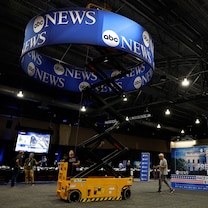White House Calls Green Energy Report Vindication
Report recommends early warning system; GOP critics say too late.
Feb. 10, 2012 — -- The White House is calling a new report on the Obama administration's controversial green energy loan program a vindication, saying that it shows the loans are less risky than either the Energy Department or Congress anticipated.
Republican critics, however, say the report's recommendation that the Department create an "early warning system" and hire a "Chief Risk Officer" is too late, since it comes only after recipients of massive federal loans have already failed. They also say the White House should not characterize a projected loss of $3 billion as a victory.
The report, conducted by an outside auditor hired by the White House, was intended to help resolve concerns triggered by the political backlash over the Obama administration's failed $535 million investment in upstart solar firm Solyndra, which declared bankruptcy last fall.
The independent auditor, Herbert Allison, recommends that the agency hire a "Chief Risk Officer" to do a better job of tracking the performance of companies that have received taxpayer-funded loans.
"To enhance the independence of the oversight function, DOE should create a new Risk Management department … dedicated to monitoring" the loans, wrote Allison.
But the 75-page review, which was released Friday, never directly addresses Solyndra's failure, or that of another DOE-backed green energy venture that went bankrupt, Beacon Power Corp. Nor does it say how well, or how poorly, other companies are performing that have benefitted from loans under President Obama's signature green energy initiative.
Allison, a longtime official in the public and private sectors who most recently served as Assistant Secretary of the Treasury for Financial Stability, writes that he "did not evaluate the loans to Solyndra and Beacon" because those companies have already failed. He also notes that his review was less exhaustive than it could have been because he was put on a fast track by the White House -- which advised him to finish his work in 60 days.
"Because of this abbreviated time period, the Independent Consultant's work plan necessarily omitted activities that might have provided further insights," Allison's report notes, "such as a more detailed examination of each loan's performance and of the financial, operational, regulatory, and market demand risks facing each loan applicant … and more extensive examination of the loan origination and monitoring processes and practices that DOE followed for each of the loans."
The report evaluated 30 loans, worth $23.4 billion, that had closed by late November 2011. Of that total, $8.3 billion, or 35 percent, had been disbursed. The money helped bankroll projects ranging from alternative energy and solar manufacturing ventures by startup companies to fuel-saving projects launched by major corporations such as Ford Motor Co. and Nissan North America, Inc.
Of that portfolio, DOE had put aside $2.9 billion to cover potential risk. Allison's review set that risk value at slightly less, $2.7 billion.
Stearns and Upton also said that Allison's suggested creation of "an early warning" system "misses the point given that the internal warnings on Solyndra were abundant well before the half a billion dollar loan guarantee was finalized. What use are early warnings if they are ignored?"
The auditor did caution that he expects a number of companies that have received loans will likely come back to the Department of Energy seeking to revise the terms. He said the rules imposed on the companies, and the complexity of their enterprises, means that "many projects are likely to seek such relief at some point during the term of the DOE loan or loan guarantee."




